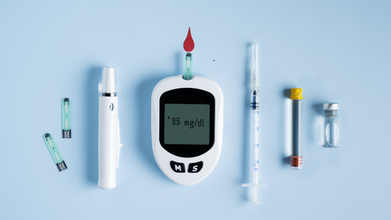- Health Conditions A-Z
- Health & Wellness
- Nutrition
- Fitness
- Health News
- Ayurveda
- Videos
- Medicine A-Z
- Parenting
Irregular Sleep, Drinking Caffeine After 3PM Could Raise Your Risk Of Heart Attack And Stroke

Irregular Sleep, Drinking Caffeine After 3PM Could Raise Your Risk Of Heart Attack And Stroke
I’ve always struggled with inconsistent sleep, staying up late and waking up at different times each day. My love for coffee was also on an all-time high with trying all the season specials. But it is only recently, I learned how this irregular sleep pattern and caffeine could increase my risk of heart attack and stroke. Now, I’m prioritizing a consistent sleep schedule and cutting out caffeine after 3 PM to protect my heart.
A new, shocking study shows that irregular sleep patterns can greatly increase the risk of heart attack and stroke. But that's not all: the timing of your caffeine intake could also play a critical role in your cardiovascular health. If you are struggling with inconsistent sleep patterns and regularly sipping on caffeinated beverages late in the day, you may be unknowingly putting yourself at risk for serious heart-related issues.
For most people, sleep is something of a given and we often only consider ourselves as long as we get our required seven to nine hours. However, according to a recent study conducted by researchers at the Children's Hospital of Eastern Ontario, it may not be that long after all. The study, which included more than 72,000 participants, found that people with irregular sleep patterns—those who fall asleep and wake up at vastly different times each day—face a 26% higher risk of experiencing a heart attack or stroke. This increased risk persisted even for those who managed to get enough sleep. The study followed up participants for eight years to track heart events such as heart attacks, strokes, and heart failure. The conclusions were clear: irregular sleep, even if it's sufficient in duration, is a major cardiovascular risk factor.
The researchers found that those whose sleep patterns were highly irregular had a significantly greater chance of life-threatening heart issues. The more erratic your sleep schedule, the greater the risk, regardless of how many hours you sleep. In fact, people with irregular sleep schedules showed worse cardiovascular health outcomes, including higher rates of high blood pressure, elevated stress hormones, and poor blood sugar and cholesterol management.
Senior scientist Dr. Jean-Philippe Chaput said "sleep regularity may be more relevant than sufficient sleep duration in modulating MACE [major adverse cardiovascular event] risk." In the study, it shows that our bodies are comfortable with consistency, and a varied sleep schedule may interfere with other processes that keep us healthy, especially the heart.
Is it Caffeine After 3 PM Causing Sleeplessness?
Another daily habit that may be putting your heart at risk is caffeine consumption after 3 PM. According to Dr. Chaput, the experts emphasize the need for a healthy sleep schedule and avoiding caffeine late in the day. Caffeine can stay in your blood for up to eight hours, and its consumption later in the afternoon can disrupt your sleep cycle.
Consistent, good-quality sleep is necessary for maintaining healthy cardiovascular function, and the disruption of this by late-day caffeine intake exacerbates the risks posed by irregular sleep. When you drink coffee, tea, or other caffeinated beverages too late, the stimulant effect on your nervous system makes it harder to fall asleep at a regular time. This can lead to inconsistent sleep patterns, which, as we have seen, can be harmful to heart health.
Dr Chaput insists that humans need to adopt practices that contribute to regularized sleep habits. This can be attained by establishing a proper sleeping and waking schedule, eliminating afternoon intake of stimulants such as caffeine, and making your body clock coincide with the lifestyle one leads.
How Does Poor Sleep Affect Heart Health?
According to the experts, the disturbance due to irregular sleep patterns impacts more than one physiological process involved in the maintenance of the healthy heart. For example, poor sleep can be associated with increased inflammation of the body, weakened immunity, and altered regulation of blood sugar and cholesterol, all of which contribute to increased blood pressure and weakening endothelial function, both associated with an increased risk for cardiovascular diseases. Sleep also plays a very important role in regulating stress hormones. Poor or disturbed sleep results in increased levels of cortisol, the stress hormone, which increases blood pressure and can have negative impacts on cardiovascular health over time.
Scientists hypothesize that these disturbances trigger a series of negative effects that enhance the risk of developing chronic heart conditions, including hypertension, atherosclerosis, or even heart failure.
Tips to Protect Your Heart and Improve Your Sleep
In order to protect your heart, experts recommend several proactive measures to improve your sleep patterns and lifestyle. First, maintain a regular sleep schedule whereby you go to bed and wake up at the same time every day, including weekends. Consistency will keep your body's internal clock in check.
Along with regulating your sleep, paying attention to your caffeine habits is just as important. To reduce your risk of heart disease and stroke, experts suggest avoiding caffeine after 3 PM. If you’re sensitive to caffeine, this rule becomes even more critical.
In addition, the introduction of stress-reducing activities like yoga or mindfulness can also be beneficial to lower cortisol levels, and therefore both sleep and heart health can improve. A diet rich in antioxidants, healthy fats, and low on processed sugars also helps maintain cholesterol levels and reduce inflammation.
Does Your Sleep Environment Also Has A Role To Play
Apart from the timing of caffeine and your sleep schedule, another very overlooked factor is the quality of your sleep environment. Scientists have long known that the environment in which you sleep has a huge impact on the quality of your rest. Poor quality of sleep, even if your sleep schedule is regular, can cause health risks that are very much the same as those that arise from irregular sleep patterns.
Here’s an additional tip: make sure your bedroom is conducive to restful sleep. This means keeping your room dark, quiet, and cool. A temperature of around 65°F (18°C) is ideal for most people. Consider investing in a comfortable mattress and pillows, and avoid screen time at least 30 minutes before bed to allow your brain to unwind.
Irregular sleep, in association with taking caffeine in late parts of the day, can risk heart attack and stroke, but a simple maintenance of a sleep schedule, the reduction of consumption of afternoon caffeine, and sleep environmental awareness can definitely safeguard one's heart along with total health.
Your sleep is more than just a time for rest; it's a vital component of your long-term health, and maintaining consistency in your sleep habits is one of the best things you can do for your heart.
Who Was Ludwig Minelli, Founder of the Swiss Right-to-Die Organization, Who Died by Assisted Suicide at 92?

Credits: AP
Ludwig Minelli, 92, died on Saturday just days before his 93rd birthday, which would have been on December 5. He was the founder of Swiss right-to-die organization Dignitas. He has died by assisted suicide.
The members of organization paid tribute to him and said that he had always led a "life for freedom of choice, self-determination, and human rights".
Right-To-Die By Minelli
Minelli founded Dignitas in 1998, which has helped many people to choose how they wish to die with dignity. He however began his career as a journalist and worked as a correspondent for the German news magazine Der Spiegel. He then studied law and that is when his interest in human rights took off.
Throughout his life, he campaigned for the right to die and gave Dignitas the slogan: "dignity in life, dignity in death".
"I am persuaded that we have to struggle in order to implement the last human right in our societies. And the last human right is the right to make a decision on one's own end, and the possibility to have this end without risk and without pain," he said in a 2010 BBC interview.
He founded Dignitas after he split from an older Swiss assisted dying organization, Exit, because he said the rules felt too restrictive.
The reason for Dignitas to become famous was because the way it operated. Dignitas offered assisted suicide to non-Swiss citizens who travel to Switzerland because assisted dying is not permitted in their own countries. In a 2008 interview to Der Tagesspiegel, he said that Dignitas assisted 840 people to die, and 60% of them were Germans.
His Life Amid Criticism And Legal Battles
While he devoted his life for a cause, he was not spared from criticism. He was often criticized for an alleged lack of transparency over the financial dealings of the organization. He was further criticized for offering assisted dying options to those who were not terminally ill, but wanted to end their lives. He also faced numerous legal battles, and many of which were also appealed to Swiss apex court.
The Wins He Made
As per Dignitas, his work had a lasting influence. In 2011, the European Court of Human Rights announced the right of a person capable of judgment to decide on the manner and the time of their own end of life.
While in his own country, assisted dying was permitted under Swiss law since 1942, under strict condition, of course, Euthanasia still remains illegal there.
The main difference is that in Switzerland, a physician cannot administer a lethal injection, which is what euthanasia is. However, a physician can provide the means for a person to end their own life, and the individual must perform the final act themselves.
The legality of assisted suicide is based on Article 115 of the Swiss Criminal Code from 1942, which prohibits assistance only if motivated by selfish reason. The conditions for assisted suicide includes that the assistance must not be for selfish motives and must be provided to someone of sound mind who has made a self-determined and enduring decision to die. The person must also be suffering from an unbearable and uncontrollable condition.
Your Butt Shape Could Be a Clue to Your Diabetes Type; Here’s How

Credits: Canva
The shape of your gluteus maximus, the largest muscle in your backside, may offer surprising clues about your likelihood of developing diabetes. New research suggests that the contours of this major muscle change with age and health conditions, helping scientists better understand how fitness, muscle health, and metabolism are connected.
Ageing, Weight, and Diabetes: What We Already Know
For years, the NHS has warned that ageing and excess weight increase the risk of developing Type 2 diabetes. However, this new study goes beyond traditional measures, proposing that the shape of the gluteus maximus itself shifts as people age or develop conditions such as osteoporosis or diabetes. These subtle muscular changes could provide valuable information about a person’s metabolic health.
Why the Gluteus Maximus Matters
Researchers from the University of Westminster highlighted that the gluteus maximus plays a key role not just in movement but also in metabolic regulation. Healthy, well-maintained muscles can improve blood sugar control and reduce the burden on organs involved in glucose processing.
Dr Marjola Thanaj, co-author of the study from the university’s Research Centre for Optimal Health, explained, as reported by Independent: “People with higher fitness, as measured by vigorous physical activity and hand grip strength, had a greater gluteus maximus shape, while ageing, frailty and long sitting times were linked to muscle thinning.”
Mapping the Muscle
To understand these differences, researchers used advanced MRI 3D mapping to create a detailed anatomical model of the gluteus maximus. By analyzing more than 61,000 MRI scans from the UK Biobank database, they discovered that the shape, not the size, of the muscle varied significantly between individuals with diabetes and those without it.
What the Study Found
The MRI analysis revealed distinct, sex-specific patterns linked to Type 2 diabetes. Among male participants living with the disease, those classified as “frail” showed widespread muscle shrinkage across the gluteus maximus, indicating a loss of muscle quality and strength.
Women with diabetes, on the other hand, had enlarged muscle shapes — not because of increased muscle strength, but because of fat infiltrating the muscle tissue. This type of fat infiltration often signals declining muscle function and poorer metabolic health.
Dr Thanaj said these patterns underline a crucial point: men and women can experience the same illness in very different biological ways, which may influence diagnosis and treatment strategies in the future.
Why Maintaining Muscle Mass Matters
Beyond appearance or strength, muscle health is essential for long-term wellbeing. Maintaining muscle mass supports blood sugar regulation, reduces the risk of cardiovascular disease, and lowers the likelihood of developing fatty liver disease, all conditions closely linked to metabolic health.
Professor Louise Thomas, senior author of the study, told The Times: “Maintaining muscle mass as we age is one of the most important things we can do for our long-term health. If people understand how important their muscles are, and make small changes to keep them healthy, that could have a huge impact on disease across the population.”
Small Steps to Strengthen Your Glutes
Improving glute muscle health doesn’t require intense gym sessions. Simple actions such as taking the stairs instead of the lift, adding squats or lunges to your routine, or breaking up long periods of sitting can help tone and strengthen the gluteus maximus.
4 Simple Tests That Can Detect Kidney Diseases Early, According To Doctor

Credits: Canva
Kidney disease is rising at an alarming pace worldwide, and it’s now among the top causes of death. A Lancet study highlights that the number of people living with chronic kidney disease jumped from 78 million in 1990 to nearly 788 million in 2023. That’s a massive tenfold spike, and a reminder that our kidneys need more attention than we realize.
The tricky part? Kidney problems often progress silently. Many people don’t realize anything is wrong until the kidneys are already significantly damaged. That’s why experts strongly emphasize early screening. According to nephrologists like Dr Arjun Sabharwal, a few simple tests — often quick and inexpensive — can help catch kidney issues early and improve treatment outcomes.
Below are the four key tests everyone should know about, especially if you have diabetes, high blood pressure, a family history of kidney disease, or you’re simply trying to stay proactive about your health.
Creatinine Blood Test & eGFR: Your First Kidney Health Check
Creatinine is a waste product filtered out by the kidneys. A routine blood test measures its level, but creatinine alone doesn’t tell the full story. That’s where eGFR (Estimated Glomerular Filtration Rate) comes in.eGFR uses creatinine values along with age and other factors to estimate how well your kidneys are functioning overall. Doctors often say, “Creatinine is just a number — eGFR tells you how much your kidneys are working.”
An eGFR below normal may be an early signal that your kidneys aren’t filtering efficiently, even if you feel fine.
Cystatin C: A More Accurate Indicator for Some People
Cystatin C is a protein produced naturally by all cells. When kidneys are healthy, its levels stay stable; when the kidneys struggle, the levels rise.
Experts highlight that Cystatin C can be more reliable than creatinine for people with very high muscle mass, those who work out intensely, or individuals taking supplements that may affect creatinine readings. If creatinine results seem unclear or inconsistent, this test adds clarity.
Urine Dipstick Test: Quick and Tells You a Lot
Before kidney function takes a major hit, the body often shows early warnings — one of which is protein leakage in urine. A urine dipstick test is one of the fastest ways to detect this.
A chemically treated strip is dipped into your urine sample, and if proteins like albumin are present, the strip changes color. It’s simple, non-invasive, and helpful for spotting early kidney damage.
Urine Protein-to-Creatinine Ratio (UPCR): How Much Protein Is Leaking
If a dipstick shows abnormalities, the next step is often a UPCR test. This test measures exactly how much protein is leaking into the urine relative to creatinine. Higher levels may signal worsening kidney function or underlying disease. Doctors use UPCR to assess the severity of kidney damage and monitor progress over time.
When to See a Nephrologist
If any test shows rising creatinine, an abnormal eGFR, protein in urine, or blood detected on a dipstick, it’s crucial to book an appointment. Lifestyle tweaks, home remedies, or detox drinks cannot reverse kidney damage. Expert evaluation is essential.
© 2024 Bennett, Coleman & Company Limited

